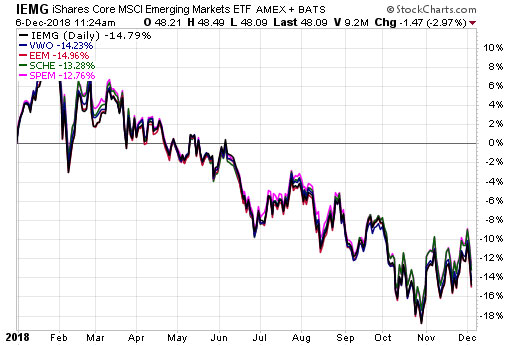[ad_1]
It’s hard to say what ETF investors are really thinking about emerging markets these days, except perhaps that if it is to buy in at current levels, it might as well be in the cheapest possible funds.
This focus on cost may stem from the fact that emerging market ETFs have struggled this year, and many of the big and broad market-cap-weighted funds remain in the red.
November seems to have brought some sort of near-term bottom to some of the largest strategies—some have been saying it’s high time for a rebound—but finding upside remains a struggle as global growth wanes and people worry about a potential recession in the U.S.

Asset Flows All Over The Place
With this backdrop, asset flows into and out of emerging market (EM) ETFs are all over the board this year. Among the biggest EM ETFs, disparity in demand is stark.
Consider that the iShares Core MSCI Emerging Markets ETF (IEMG) has gathered an impressive $14.5 billion year-to-date, making it one of 2018’s most popular ETFs. Meanwhile, its counterpart iShares MSCI Emerging Markets ETF (EEM) has bled $4.7 billion year-to-date, bringing its total assets to under $30 billion.
Both funds are linked to MSCI’s view of the developing world, which has South Korea among the biggest emerging markets, but IEMG costs only 0.14% in expense ratio, compared with EEM’s annual expense ratio of 0.69%.
Outside the iShares family of funds, divergence in asset flows is also notable. The massive Vanguard FTSE Emerging Markets ETF (VWO)—the biggest emerging market ETF today, with $57.7 billion in total assets and as cheap as IEMG—has seen $834 million in assets leave the fund year-to-date.
South Korea Factor
But the $4.9 billion Schwab Emerging Markets Equity ETF (SCHE)—costing only 0.13% in expense ratio—has attracted some $660 million in net creations. Both VWO and SCHE track FTSE benchmarks that exclude South Korea from the mix, and lead the portfolio with allocations to China and Taiwan. Under FTSE’s classification, South Korea is no longer a developing market.
And then there’s the $1.8 billion SPDR Portfolio Emerging Markets ETF (SPEM), which tracks an S&P benchmark that also excludes South Korea. The 1,400-security fund has gathered nearly $1 billion in net assets this year. SPEM is the cheapest of them all, at 0.11%.
IEMG, SPEM and SCHE are among the year’s most in-demand EM ETFs. The biggest difference between these funds—the allocation or exclusion to South Korea that accounts for about 14% of IEMG and EEM—has mattered in performance since 2018 and has been challenging for that country’s stock market.
Consider the performance of the iShares MSCI South Korea ETF (EWY), which tracks a market-cap-weighted index of large- and midcap Korea firms. It offers a glimpse into that market’s weakness—one that helps explain IEMG’s relative underperformance to VWO.

Charts courtesy of StockCharts.com
Whether or not you believe South Korea belongs in your emerging market portfolio, when your fund is down 14-15% in 11 months, paying as little as possible for market access that’s pretty similar across these big ETFs makes a lot of sense. The less you pay, the more you keep.
Contact Cinthia Murphy at [email protected]
[ad_2]
Source link

